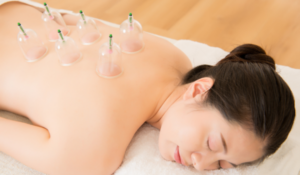What You Should Know about Cupping—And Why You May Want to Try It
You may know that cupping is practiced by certain celebrities, or that it leaves telltale reddish-purple marks on the skin. But do you know what it’s really all about and how it can benefit you?
Cupping has become a growing trend in recent years, thanks to its popularity among athletes (Michael Phelps, tennis player Andy Murray) and actors (Gwyneth Paltrow, Jennifer Aniston). But it dates back thousands of years, with historical evidence that it was practiced in ancient China, Egypt, and the Middle East. The Chinese, for instance, believed cupping allowed the body’s energy force, or qui, to flow freely while also balancing the yin and yang. Today, people get cupping for any number of reasons.
How Cupping Works
Not surprisingly, cups are key in cupping. The cups can be made of glass, silicone, plastic, bamboo, or ceramicware. Traditionally, the cups are heated to create an oxygen deficit and then placed on the back to create suction. However, many massage therapists today get that suction effect with a special pump device after the cups are on the body.
The cups are left on the body (usually the back and shoulders, although they can be placed on the scalp, torso or legs) for a few minutes. Some practitioners may slide the cups around a client’s oiled back, which is considered sliding cupping. The suction feeling isn’t painful; in fact, many people find the process relaxing.
After the cups are removed, there are typically reddish-purple round marks left behind on the skin as a result of the suction. These marks generally fade away in about a week.
What Does Cupping Do for Your Body?
The suctioning action uses negative pressure causing the underlying tissue to pull up and away from the body, focusing on the connective tissues, which are called fascia. These tissues help the muscle fibers move easily and effortlessly—when they’re in good condition. When fascia isn’t healthy it may cause problems such as muscle tension, lack of flexibility, and back pain.
The goal of cupping is to maintain healthy fascia, which then helps with muscle pain, blood circulation, flexibility, and body inflammation. It’s also thought that new, healthy fascia can be produced as a result of cupping. Many people rely on cupping to ease symptoms and pain related to injuries, muscle strains, and sprains. While research has been limited, studies indicate cupping may be beneficial for conditions such as acne, facial paralysis, herpes zoster, and lumbar disc herniation.
Try Cupping at Firefly
If you’re interested in cupping or it sounds like something that might be beneficial for you, come try it at Firefly! All of our therapists are trained in cupping, and it can be integrated into your massage session as an add-on. If you have questions about the process, or you have certain medical conditions, we’re happy to discuss them with you to make sure you have the best possible cupping experience. We provide massage services at our Mission Hills spa, and we continue to book appointments where our therapists come to your home and perform the massage in an outdoor space, with face masks worn at all times.
Contact us today to learn more about cupping or schedule an appointment.

